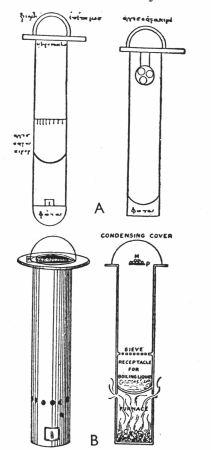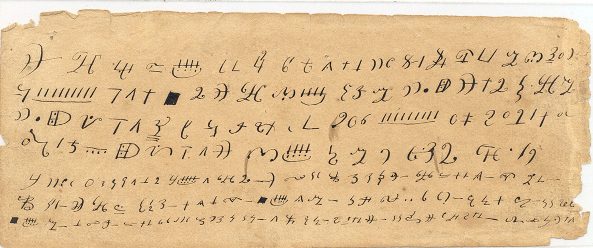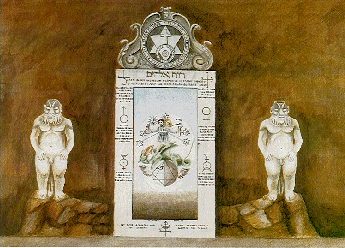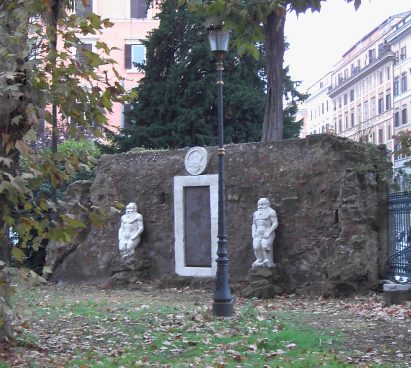|
|
 Questions from my Inbox
Questions from my InboxI receive many questions by email. Often these are requests for simple facts or some explanation of some point, even for help finding things on my website ! Sometimes they are from people who have just discovered the subject and want more information or even to ventilate their initial opinions about alchemy. I also get emails asking me to try and identify some image that the sender believes is alchemical in origin. Many of these questions and my answers are only of importance to the sender, but occasionally someone asks a question that perhaps states a point that perhaps has some wider interest to other readers of the alchemy website. So I have decided to occasionally place these interesting questions onto this page. I will, of course, remove details of the sender, as I only wish to share the contents of the email and my replies. The sender's questions are in the bold grey font, while my replies are in the light white font.  Nov 18 2008
Nov 18 2008I was wondering if you could give me some information about the kerotakis attributed to Maria Prophetissa? Are there any drawings / schematics of the apparatus? The kerotakis was originally a metal plate over a charcoal burner which artists in Greek times used to keep their paints liquid. These paints were based on beeswax and consequently had to be heated in order that they would flow. Later this idea was developed into an apparatus for alchemical use. This consisted of a tall cylinder, heated at the bottom by a furnace perhaps with charcoal or wood. This heated a substance such as mercury or sulphur set in a section above the furnace and the hot fumes rose up inside the cylinder. At the top there was a little plate with holes through which the fumes could pass. In the centre of this plate the alchemist placed the metal or ore which was to be reacted upon by the vapours. On top of the kerotakis tower was a removeable hemispherical lid, inside which the vapours would condense and then run back down to the bottom of the kerotakis, back into the section containing the liquid.  Nov 11 2008
Nov 11 2008I have an alchemy-related question for you about Nicolas Flamel. I saw some scans on another website claiming to be of Flamel's notebook:- My first assumption would be that this is, like the Flamel Testament, a much later-dated fake: but may I ask if you happen to know of any literature on it? It was a new one to me. All Flamel material is "fake" in one sense. There was no late 14th century alchemist called Flamel. His writings were "invented" in the late 16th and early 17th centuries. There was an actual historical Nicolas Flamel, but despite much documentation surviving of his life, he was not involved in alchemy. There is a good study in French on this by Nigel Wilkins Nicolas Flamel. Des Livres et de l'or. Paris, 1993. Professor Wilkins surveys all the historical material surviving on Flamel, going back to the original material from the late 14th Century, with details of the actual real Flamel, as revealed in the various family wills and other documents of that period. Unfortunately no one seems to want to read Wilkins' book. People prefer the fantasy and legend. There were two main periods of the invention of Flamel writings - first, the late 16th and early 17th centuries, during which time there was an obsession with the antiquity of alchemy and consequently people created texts purporting to be from this early period (Flamel, Basil Valentine, Ramon Lull, etc) - and second the 18th century in France, when a growing nationalism in France led to some people wanting to claim a frenchman Flamel as one of the earliest of alchemists, and thus they created a new cycle of "Flamel" manuscripts. Among these are the many manuscripts entitled 'Livre des Figures hi�roglyphiques'. These were anachronistically painted on vellum to give an air of authenticity. The images you show are from MS. Francais 14765 in the Bibliotheque Nationale "Alchimie de Flamel, par le Chevalier Denis Molinier", and is dated 1772-73. Although contrived they are not "fakes" in the sense of forgeries for profit, rather they are attempts to reconstuct the past, by devising an object apparently emerging from a personality they wished had existed. Nov 11 2008 Are there any explanations of the symbols of alchemy i.e. the sign such as sulphur, limestone , gold etc ? These symbols evolved over a century or more, and were not necessarily based on an underlying structure (except in a very few cases). So they are not really "explainable", but must be seen as the end point of some process of evolution through a series of manuscripts and printed books. Although I have books that give me a number of explanations for these symbols they are few in number, and I was hoping that you may have a more comprehensive list. I have a reproduced the rather comprehensive list in Medicinisch-Chymisch- und Alchemistisches Oraculum, Ulm, 1755. www.alchemywebsite.com/alchemical_symbols00.html which has multiple variations and versions for different substances and processes. Nov 01 2008 My questioner of Nov 01 replies One question remains: On your photo you got bags under your eyes, your hair has partially lost its color, etc. all signs of old age. If you are a practicing alchemist, then how come none of what you've come up with has rejuvinated you? Rejuvination is a consequence of taking the universal medicine, the elixir of life, to some extent, espcially when taken daily. I believe this may arise from the fact that I live in the real world, and not some self-deceptive fantasy ! Nov 02 2008 I was hoping you could explain the meaning of the phrase "the bird of Hermes is my name, eat my wings to make me tame" from the Ripley Scroll. One cannot explain a single phrase out of context. The whole work has to be taken into consideration. I have, in fact, written a study course which explains the Ripley Scroll. Sorry, but a complex work like the Ripley Scroll cannot be explained in a few sentences. If it could be easily explained in this way, alchemy would be a simple matter and of little interest to people. Nov 01 2008 1. How can I go about fermenting saliva? Is this an anearobic or aerobic fermentation process? (nothing is added to the saliva) Any special temperature that is advised? Length of days to let saliva ferment before blue-green crystals start forming at the bottom of the jar? Any ideas would be much appreciated. (these crystals can transmute base metals into gold) I have no idea. Sorry, fermenting saliva is not the sort of thing in which I have much interest. Saliva only appears in a few alchemical works,however, it would appear to be used more in an allegorical sense, such as "spittle of the Moon", rather than as actual saliva. I very much doubt that "these crystals", if indeed they appear, will produce the result you indicate. Turning saliva into gold sounds a bit too good to be true ! Perhaps this is a joke.  2. I can't find on google what a 'bolthead' is supposed to be. I guess it is that which tops a distillation flask, but do you perhaps have a picture of one or two for me? I need to know this for another alchemical experiment.
2. I can't find on google what a 'bolthead' is supposed to be. I guess it is that which tops a distillation flask, but do you perhaps have a picture of one or two for me? I need to know this for another alchemical experiment.
A bolt head in French's Book of distillation is a tall long-necked flask. He describes it thus: Put what matter you please into a bolt head with a long neck or pipe, put this pipe through a pan that has a little hole made in the bottom, that the top of it may be three or four inches above the pan. Close up the hole round about the pipe with clay. Then put coals in the pan and kindle first those that are furtherest off from the pipe that the heat may come by degrees to the pipe (for otherwise a sudden heat will break it). When the pipe is hot, blow the coals about it until it melts. Then with a pair of shears, cut it off where it is melted, and then with a pair of tongs close it together. 3. How do I go about melting purified sea salt? Temperature needed? Equipment to fire and what to use to hold the salt? Salt melts at 800 degrees centigrade, easily done in a silica crucible using a gas flame.  4. How do I best go about collecting morning dew?
4. How do I best go about collecting morning dew?
There are a number of methods. The traditional way is to use cloths which are pegged out overnight on meadows as pictured in the Mutus liber. Barbault in the 1970s chose to drag canvas cloths across long grass laden with dew. I have even heard of someone using an electrical dehumidifier, definitely the lazy man's method. Oct 17 2008 How many alchemical manuscripts are there in existence? Many thousands. I have a database of information I collected back in the 1990's which has descriptions of 4000 alchemical manuscripts. This is incomplete and I estimate there must be at least two to three thousand more that I have not yet added to this list. These are bound manuscript volumes often containing a number of different works, so if one estimates an average of four or five items in each volume, I suppose one gets to a figure closer to twenty thousand. Manuscripts are very variable and range from letters, notes on recipes, notes on books, transcriptions of books or other manuscripts, translations of books or manuscript, as well as original pieces of writing. Incidentally, the word "manuscript" refers to something written by hand. I often notice that some americans use the term to refer to any ancient ancient work - thus they apply this to printed books. Technically, a manuscript is a unique item written by hand, and not a printed item. My database of printed books shows 4600 items, and there are probably a few more needing to be added and described. You can see my databases of manuscripts and printed books here. Oct 16 2008 I think you have written that the alchemy has nothing to do with the Grail, but I have read a big book by Jung which proves this is actually true. I think you may be referring to Emma Jung and Marie-Louise von Franz's book The Grail Legend the English edition of which appeared in 1971. In some sections of this book the authors try to find alchemical symbols that parallel aspects of the Grail stories. While this is a nice exercise, I wonder if it actually provides us with any significant information about actual real links (outside the modern mind) between alchemy and the Grail. This book was very influential and many later writers take up their ideas. I tend to take a slightly different perspective on the question as to whether the alchemy and the Grail legends are interlinked. Instead of looking for alchemical symbols in Grail stories, I would look for evidence that alchemists were actually interested in the Grail. As there are so many (by factor of hundreds) more original alchemical manuscripts and printed books than original Grail sources, one might expect to find some record, in these original manuscripts and books, of alchemists being intrigued by Grail ideas and using them in their writings. However, there is no trace in the writings of historical alchemists of such concerns. Indeed, the only mention of anything remotely connected with Grail ideas in alchemical works are a few manuscripts with which the name "Merlin" was associated. The main text is the Allegory of Merlin which you can read on my web site. You will see that it has nothing to do with the Grail and Celtic Merlin. The name was probably borrowed, as at that time Merlin had the image of an ancient sage, like as Hermes. The alchemical content of the Merlini allegory is linked to the well known alchemical Duenech allegory, and has nothing at all to do with Grail imagery, as you will see if you read through it. Merlin here is transported back to Alexandrine Egypt! It is the lack of any alchemical source material having any association with Grail imagery, that leads me to question any real connection. Modern popular writers and those working with depth pyschological ideas will find connections, but these really only exist for the modern mind, they are not found in the historical alchemical source material I am aware of at present. Without such sources the idea is purely speculative and rests on the attitudes and mindset of the modern age, rather than being a real part of alchemical history. However, that does not stop people writing big books about it ! I don't really understand why you are so against the Grail. The Grail was all about kings and queens and they are also in the alchemical pictures you have on your website. So why are these not connected with alchemy. Other people write books about this. They can't all be wrong. The Grail stories were written in the late 12th and early 13th centuries. The two main authors were Chr�tien de Troyes (1135 - 1183) and Wolfram von Eschenbach (1170-1220). The first appearance of the sort of emblematic alchemical symbolism with kings and queens and similar allegorical imagery begins to appear in the last decades of the 14th century - about 200 years after the creation of the Grail stories. So there is no way alchemical imagery could have influenced the creation of these stories, as it did not exist at that time. Also from the evidence of their writings, alchemists had no interest in the Grail, as I said earlier. Oct 15 2008 What is the true difference between the words alchemy and chemistry ? I suppose that depends on which century you are living in. In the 15th, 16th and 17th centuries, there was no difference. Terms such as alchymia, chemia, alchemia, chymica, were used interchangeable, with little discernable difference of meaning. From about the end of the 17th Century, with the rise of qualitative science, there began a gradual polarisation into alchemy and a newly emerging chemistry, however, while this process was ongoing many people were not necessarily aware of the change in attitude that was developing towards materials and experimentation, so these terms co-existed alongside each other. By the beginning of the 19th century the rapid developments in what we now recognise as chemistry had led to a clear split, and interest in alchemy waned. Alchemy then became identified as something archaic. Nowadays the words alchemy and chemistry apply to different domains. I'm doing some research on Alchemy and Shakespeare and I find Google keeps sending me to your website...but even though you have a lot of great stuff, I don't see a definitive artlcle on Shakespeare. The influences of alchemy on Shakespeare are rather speculative. One can see clearly the influence of alchemy on his contemporary Ben Jonson. Jonson obviously had read a number of alchemical works and was familiar with alchemical ideas. Shakespeare would have had the same opportunity to familiarise himself with alchemical writings as Jonson, but it surely is obvious that he did not use such obvious alchemical references as Jonson did. So one can conclude that Shakespeare was not especially driven to incorporate alchemical ideas in his work. I can trace a lot of alchemical references...for example, the intense use of the "mettle/metal" pun...but, don't know what to make of it. One can easily read such things into a text. It seems hardly convincing. What one needs are clear alchemical references. That's just one of the things I'm working on that require me to have a sense of what this author is trying to say and hide at the same time. Why hide ! There was no need to hide anything. Jonson's work openly referred to alchemical ideas. My main advice is not to read too much into a few phrases. I have a recipe (for lack of a better word) that is full of alchemical symbols. The recipe is from the early 19th century, but looks to be based on some older styles, possibly even some local symbols. 
This is unlikely to be an alchemical recipe as such. This is an example of a standard coded text, seemingly using a substitution code. The text would appear to consist of a series of symbols substituted for alphabetic characters. This was in common use in 17th and 18th century (an even later). To break the code you only need to list each character and draw up a table listing the number of times each of these appears in the coded text. Then list these in order of the most frequent. These will correspond (in most European languages) to about the same distribution. You can start by assuming it is in English and get the frequency table for English off the internet. Then it is just a matter of trying to recognise patterns. You could even post this on one of the amateur cryptographers discussion forums on the internet and someone may take the bother to decode it for you. It is quite short so it could be a bit more difficult. To help the decoder you should provide the context within which the text was found. You will probably find it decodes into something rather trivial ! I wanted to ask if you are familiar with ORMUS, and if so, for your honest assessment about its connection to The Philosopher's Stone. Yes I know all about this. I was well informed during the emergence of this fantasy during the middle 1990s. As far as I am concerned this is just a modern scam. In the debate over spiritual vs. physical alchemy being the 'true' art, what is your view? I am only interested in historical alchemy - the alchemy we find in the books of the alchemists. I have little interest in the contrived ideas of modern writers. Are there any traditions (besides ORMUS) that presently claim physical alchemy as being the 'true' art? If so, who are they? There are lots of other people making such claims. It is a common feature in people posing as adepts. Thanks for your reply. May I ask, how did you determine ORMUS to be a 'scam'? Well, I do have the ability to think clearly and assess evidence. I also followed the early development of this and was in contact with some of the major players in this field, so I know what went on in the formulation of this scam. What is 'historical alchemy'? By 'historical alchemy' one means the actual alchemy as is found in the historical record. Thus the texts, images, manuscripts and documents found in libraries and specialist collections are the records of the actual alchemy as it was in the 15th -16th - 17th and 18th centuries. Modern alchemy, is entirely invented in the modern age, and has nothing to do with what was actually practiced by real historical alchemists. Almost all the books about alchemy in the 20th and 21st centuries are totally contrived and invented out of modern writers' imaginations. They are, for the most part, fantasy. I am only interested in real alchemy, the alchemy of the actual alchemists, not modern posturers. I found this image on your website, really amazing and very singular. 
I found this image of the actual place in Rome. 
Yes this carved gate is well known. It was part of the Palombara estate in the 17th century. http://it.dada.net/freeweb/luoghidelmistero/la_porta_ermetica.htm Art of Cyprian. I've recently become quite interested in Frederick Hockley and was wondering about this manuscript. May I enquire as to what became of your intentions to publish this? Where may a copy of the ms. be obtained from - is it in private hands like so many his others? It is in the Ferguson collection here at Glasgow University library - MS Ferguson 101. Furthermore, would you be able to tell me whether the ms you looked at was Hockley's transcription or not? As far as I remember (it being more than 20 years since I looked at this) it was a transcription by Hockley (or even a translation) of a unidentified manuscript. I think that might be a good thing to have on your site a brief description of what alchemy is. There is no simple definition of 'alchemy', just as there is no simple definition of 'art', or of an abstract idea such as 'goodness'. Definition of terms such as these, impose a meaning upon them from the perspective of the person applying the definition. The answer to "what is..." thus depends on the mindset of the person answering. I�m conducting research on the script of the Emerald Tablet. I noticed it is listed as Phoenician on alchemy lab's website. This is a result of a misunderstanding. In the 17th century a supposed reconstruction of the Emerald Tablet was issued as an engraving in a printed book. This was entirely created at that time. The text of the 'Emerald tablet', or rather phrases found in this text were found in some later Arabic manuscripts, and first appeared in Europe in Latin. The whole tone of the work would appear to be Greek in conception, but no Greek source has yet been found. Does an image of the actual 'Tablet' exist? Was there even a tablet? It is a text. The myth was that it was originally carved on a stone tablet (or even on an emerald) found in a cave. This myth of some sacred text being carved on a tablet is quite common, and was applied to other texts. Just think of the Biblical Ten Commandments found by Moses. If a person is called to the alchemical wedding and doesn't manage to "die", what happens to that person. What does it mean to burn? Where does the soul go? These are all allegories. The professors who knew me best at school told me that the best vocation for me would be an independent scholar.... I recently read some information online about independent scholars, and I have learned, as you mentioned in your interview, that scholars who are not 'academics' are sometimes looked down on by professors. The problem with the term 'independent scholar' is that anyone can describe themselves as such - whereas a Ph.D. is something awarded to you by others. Thus the category of 'independent scholar' includes the barking mad, as well as sensible people who have educated themselves. The problem with self-education is that one can deceive oneself and fail to have sufficient logicality or objectivity - and thus ones 'scholarship' is merely rhetorical posturing. At the very least one is patronised by the scholarly world - one will certainly not be invited to participate in scholarly conferences or asked to write articles for scholarly journals. I live in the USA, and, so far as I know, there are no libraries in this country that specialize in alchemical or hermetic texts (I could be mistaken, but I can't think of any such libraries at this time). The University of Wisconsin has the Duveen Collection - one of the best in the world. You will not find many alchemical works missing from this collection. You could study there for a lifetime and not exhaust the material. I was wondering, and I hope this does not sound foolish, but do you believe that there is any religious tradition that enhances ones experience of alchemy? One needs to have some understanding of Medieval and Renaissance European Christianity, and some awareness of the Protestant movement which emerged some way though the evolution of alchemy. In the USA Gnosticism is becoming very popular and some say that Gnosticism is one of the best religions in which to experience alchemy. The term 'Gnosticism' like 'alchemy' is not well defined and indeed much modified by modern commentators. Knowledge of Gnostic texts, it appears, only emerged in the 19th century. Before then there was very little access to Gnostic texts. Few alchemists could have had any encounter with Gnosticism or Gnostic ideas. However, I read in one of the interviews on your page that alchemy in the last 100 years has become entrenched in esotericism and new age thinking. There is a clear divide between historical alchemy, and the modern construct called 'alchemy' that emerged out of the esoteric/ theosophical/ Jungian/New Age mentality. This modern 'alchemy' is worth studying as a thing it itself, but it does not give us any insight into the alchemy of the 15-18th centuries as almost none of the modern synthetic ideas existed during that time. Even the term 'esoteric' is a modern one - it is not found in early books, and seems not to have emerged till the late 17th and 18th centuries. |